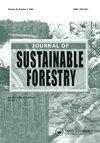A model of cross-sectional growth of Cunninghamia lanceolata plantation in Hunan province with climate effects
IF 1.8
4区 农林科学
Q3 FORESTRY
引用次数: 0
Abstract
Objective: The influence of climate on forest stands cannot be ignored, but most of the previous forest stand growth models were constructed under the presumption of invariant climate and could not estimate the stand growth under climate change. The model was constructed to provide a theoretical basis for forest operators to take reasonable management measures for fir under the influence of climate. Methods: Based on the survey data of 638 cedar plantation plots in Hunan Province, the optimal base model was selected from four biologically significant alternative stand basal area models, and the significant climate factors without serious covariance were selected by multiple stepwise regression analysis. The optimal form of random effects was determined, and then a model with climatic effects was constructed for the cross-sectional growth of fir plantations. Results: Richards formula is the optimal form of the basic model of stand basal area growth. The coefficient of adjustment was 0.8355; the average summer maximum temperature and the water vapor loss in Hargreaves climate affected the maximum and rate of fir stand stand growth respectively, and were negatively correlated with the stand growth. The adjusted coefficient of determination of the fir stand area break model with climate effects was 0.8921, the root mean square error (RMSE) was 3.0792, and the mean relative error absolute value (MARE) was 9.9011; compared with the optimal base model, improved by 6.77%, RMSE decreased by 19.04%, and MARE decreased by 15.95%. Conclusion: The construction of the stand cross-sectional area model with climate effects indicates that climate has a significant influence on stand growth, which supports the rationality of considering climate factors in the growth model, and it is important for the regional stand growth harvest and management of cedar while improving the accuracy and applicability of the model.气候影响下湖南杉木人工林横截面生长模式
目的:气候对林分生长的影响不容忽视,但以往的林分生长模型大多是在假定气候不变的情况下构建的,无法对气候变化下的林分生长进行估算。建立模型,为森林经营者在气候影响下对冷杉采取合理的管理措施提供理论依据。方法:基于湖南省638个杉木人工林样地的调查数据,从4个具有生物显著性的备选林分基面积模型中选择最优的基础模型,并采用多元逐步回归分析方法选择无严重协方差的显著气候因子。确定了随机效应的最优形式,并在此基础上建立了冷杉人工林横截面生长的气候效应模型。结果:Richards公式是林分基面积生长基本模型的最优形式。调整系数为0.8355;夏季平均最高气温和哈格里夫斯气候的水汽损失量分别影响冷杉林分生长最大值和生长速率,且与林分生长呈负相关。考虑气候影响的杉木林分断裂模型的校正决定系数为0.8921,均方根误差(RMSE)为3.0792,平均相对误差绝对值(MARE)为9.9011;与最优基础模型相比,改进了6.77%,RMSE降低了19.04%,MARE降低了15.95%。结论:考虑气候影响的林分横截面积模型的构建表明,气候对林分生长有显著影响,支持了生长模型中考虑气候因素的合理性,在提高模型准确性和适用性的同时,对杉木区域林分生长收获和管理具有重要意义。
本文章由计算机程序翻译,如有差异,请以英文原文为准。
求助全文
约1分钟内获得全文
求助全文
来源期刊

Journal of Sustainable Forestry
Social Sciences-Geography, Planning and Development
CiteScore
3.90
自引率
12.50%
发文量
42
期刊介绍:
Journal of Sustainable Forestry publishes peer-reviewed, original research on forest science. While the emphasis is on sustainable use of forest products and services, the journal covers a wide range of topics from the underlying biology and ecology of forests to the social, economic and policy aspects of forestry. Short communications and review papers that provide a clear theoretical, conceptual or methodological contribution to the existing literature are also included in the journal.
Common topics covered in the Journal of Sustainable Forestry include:
• Ecology, management, recreation, restoration and silvicultural systems of all forest types, including urban forests
• All aspects of forest biology, including ecophysiology, entomology, pathology, genetics, tree breeding, and biotechnology
• Wood properties, forest biomass, bioenergy, and carbon sequestration
• Simulation modeling, inventory, quantitative methods, and remote sensing
• Environmental pollution, fire and climate change impacts, and adaptation and mitigation in forests
• Forest engineering, economics, human dimensions, natural resource policy, and planning
Journal of Sustainable Forestry provides an international forum for dialogue between research scientists, forest managers, economists and policy and decision makers who share the common vision of the sustainable use of natural resources.
 求助内容:
求助内容: 应助结果提醒方式:
应助结果提醒方式:


